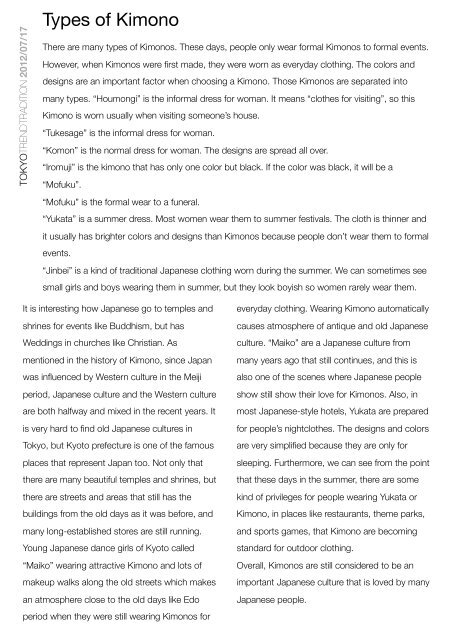Tokyo trend tradition
Tokyo trend tradition
Tokyo trend tradition
Create successful ePaper yourself
Turn your PDF publications into a flip-book with our unique Google optimized e-Paper software.
TOKYOTRENDTRADITION 2012/07/17<br />
Types of Kimono<br />
There are many types of Kimonos. These days, people only wear formal Kimonos to formal events.<br />
However, when Kimonos were first made, they were worn as everyday clothing. The colors and<br />
designs are an important factor when choosing a Kimono. Those Kimonos are separated into<br />
many types. “Houmongi” is the informal dress for woman. It means “clothes for visiting”, so this<br />
Kimono is worn usually when visiting someone’s house.<br />
“Tukesage” is the informal dress for woman.<br />
“Komon” is the normal dress for woman. The designs are spread all over.<br />
“Iromuji” is the kimono that has only one color but black. If the color was black, it will be a<br />
“Mofuku”.<br />
“Mofuku” is the formal wear to a funeral.<br />
“Yukata” is a summer dress. Most women wear them to summer festivals. The cloth is thinner and<br />
it usually has brighter colors and designs than Kimonos because people don’t wear them to formal<br />
events.<br />
“Jinbei” is a kind of <strong>tradition</strong>al Japanese clothing worn during the summer. We can sometimes see<br />
small girls and boys wearing them in summer, but they look boyish so women rarely wear them.<br />
It is interesting how Japanese go to temples and<br />
shrines for events like Buddhism, but has<br />
Weddings in churches like Christian. As<br />
mentioned in the history of Kimono, since Japan<br />
was influenced by Western culture in the Meiji<br />
period, Japanese culture and the Western culture<br />
are both halfway and mixed in the recent years. It<br />
is very hard to find old Japanese cultures in<br />
<strong>Tokyo</strong>, but Kyoto prefecture is one of the famous<br />
places that represent Japan too. Not only that<br />
there are many beautiful temples and shrines, but<br />
there are streets and areas that still has the<br />
buildings from the old days as it was before, and<br />
many long-established stores are still running.<br />
Young Japanese dance girls of Kyoto called<br />
“Maiko” wearing attractive Kimono and lots of<br />
makeup walks along the old streets which makes<br />
an atmosphere close to the old days like Edo<br />
period when they were still wearing Kimonos for<br />
everyday clothing. Wearing Kimono automatically<br />
causes atmosphere of antique and old Japanese<br />
culture. “Maiko” are a Japanese culture from<br />
many years ago that still continues, and this is<br />
also one of the scenes where Japanese people<br />
show still show their love for Kimonos. Also, in<br />
most Japanese-style hotels, Yukata are prepared<br />
for people’s nightclothes. The designs and colors<br />
are very simplified because they are only for<br />
sleeping. Furthermore, we can see from the point<br />
that these days in the summer, there are some<br />
kind of privileges for people wearing Yukata or<br />
Kimono, in places like restaurants, theme parks,<br />
and sports games, that Kimono are becoming<br />
standard for outdoor clothing.<br />
Overall, Kimonos are still considered to be an<br />
important Japanese culture that is loved by many<br />
Japanese people.


